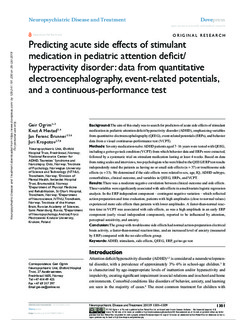| dc.contributor.author | Øgrim, Kjell Geir | |
| dc.contributor.author | Hestad, Knut | |
| dc.contributor.author | Brunner, Jan | |
| dc.contributor.author | Kropotov, Yury | |
| dc.date.accessioned | 2019-10-28T09:42:59Z | |
| dc.date.available | 2019-10-28T09:42:59Z | |
| dc.date.created | 2013-11-20T18:35:18Z | |
| dc.date.issued | 2013 | |
| dc.identifier.citation | Neuropsychiatric Disease and Treatment. 2013, 9 1301-1309. | nb_NO |
| dc.identifier.issn | 1176-6328 | |
| dc.identifier.uri | http://hdl.handle.net/11250/2624818 | |
| dc.description.abstract | Background: The aim of this study was to search for predictors of acute side effects of stimulant medication in pediatric attention deficit/hyperactivity disorder (ADHD), emphasizing variables from quantitative electroencephalography (QEEG), event-related potentials (ERPs), and behavior data from a visual continuous-performance test (VCPT).
Methods: Seventy medication-naïve ADHD patients aged 7–16 years were tested with QEEG, including a go/no-go task condition (VCPT) from which behavior data and ERPs were extracted, followed by a systematic trial on stimulant medication lasting at least 4 weeks. Based on data from rating scales and interviews, two psychologists who were blind to the QEEG/ERP test results independently rated the patients as having no or small side effects (n = 37) or troublesome side effects (n = 33). We determined if the side effects were related to sex, age, IQ, ADHD subtype, comorbidities, clinical outcome, and variables in QEEG, ERPs, and VCPT.
Results: There was a moderate negative correlation between clinical outcome and side effects. Three variables were significantly associated with side effects in a multivariate logistic regression analysis. In the ERP independent component – contingent negative variation – which reflected action preparation and time evaluation, patients with high amplitudes (close to normal values) experienced more side effects than patients with lower amplitudes. A faster-than-normal reaction time in VCPT was associated with side effects, as was a high amplitude in an early ERP component (early visual independent component), reported to be influenced by attention, perceptual sensitivity, and anxiety.
Conclusion: The group with troublesome side effects had normal action-preparation electrical brain activity, a faster-than-normal reaction time, and an increased level of anxiety (measured by ERP) compared with the no side-effects group. | nb_NO |
| dc.language.iso | eng | nb_NO |
| dc.publisher | Dove Medical Press | nb_NO |
| dc.rights | Navngivelse-Ikkekommersiell 4.0 Internasjonal | * |
| dc.rights.uri | http://creativecommons.org/licenses/by-nc/4.0/deed.no | * |
| dc.title | Predicting acute side effects of stimulant medication in pediatric attention deficit/hyperactivity disorder: data from quantitative electroencephalography, event-related potentials, and a continuous-performance test | nb_NO |
| dc.type | Journal article | nb_NO |
| dc.type | Peer reviewed | nb_NO |
| dc.description.version | publishedVersion | nb_NO |
| dc.source.pagenumber | 1301-1309 | nb_NO |
| dc.source.volume | 9 | nb_NO |
| dc.source.journal | Neuropsychiatric Disease and Treatment | nb_NO |
| dc.identifier.doi | 10.2147/NDT.S49611 | |
| dc.identifier.cristin | 1067665 | |
| dc.description.localcode | © 2013 Ogrim et al. This work is published by Dove Medical Press Ltd, and licensed under Creative Commons Attribution – Non Commercial (unported, v3.0) License | nb_NO |
| cristin.unitcode | 194,67,40,0 | |
| cristin.unitcode | 194,65,30,0 | |
| cristin.unitcode | 1920,5,0,0 | |
| cristin.unitname | Institutt for psykologi | |
| cristin.unitname | Institutt for nevromedisin og bevegelsesvitenskap | |
| cristin.unitname | Klinikk for fysikalsk medisin og rehabilitering | |
| cristin.ispublished | true | |
| cristin.fulltext | original | |
| cristin.qualitycode | 1 | |

